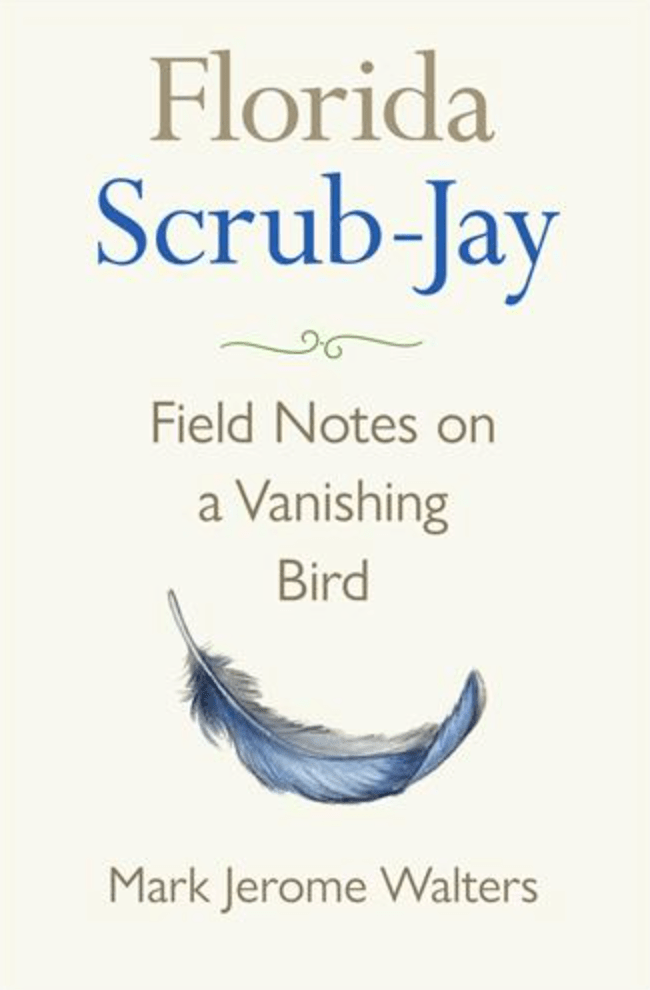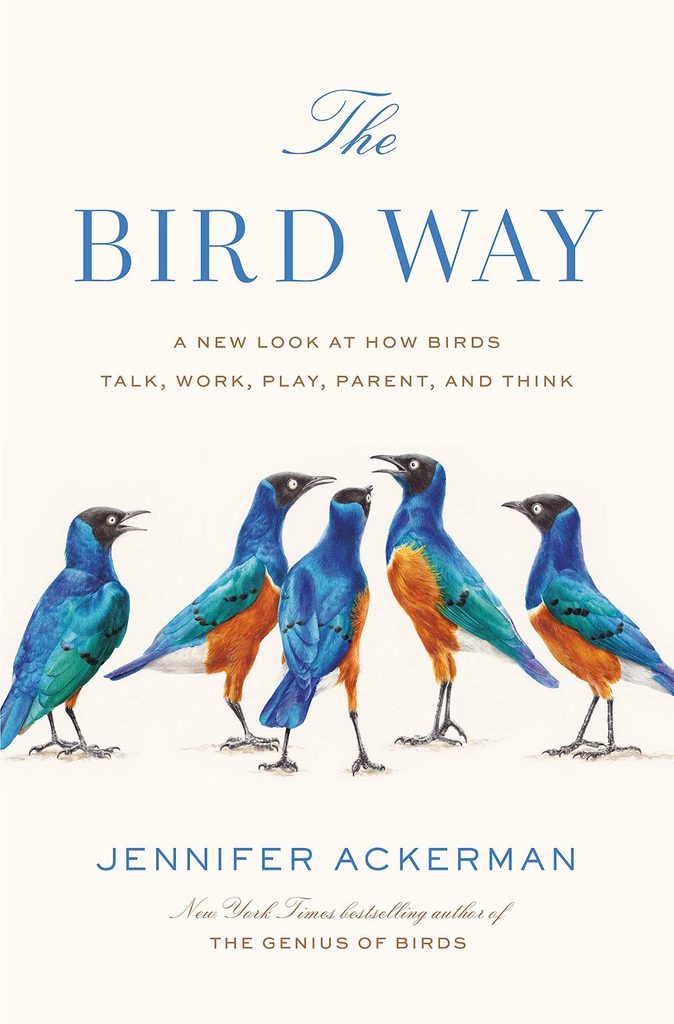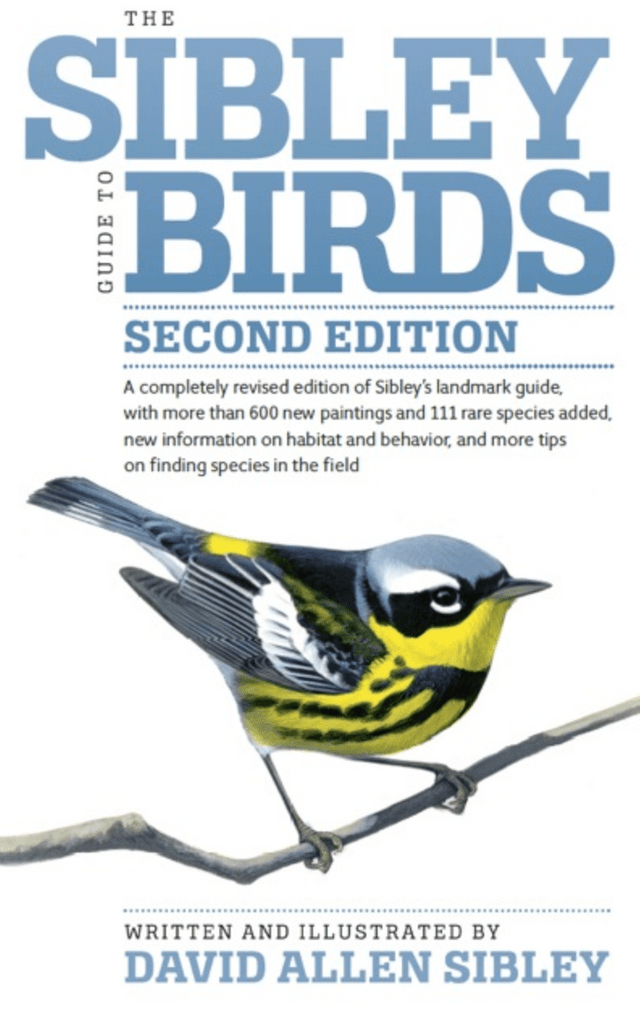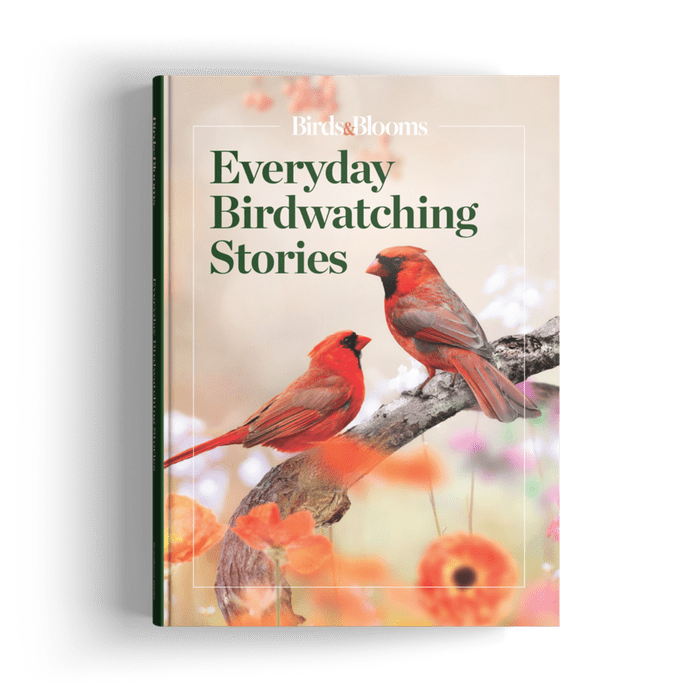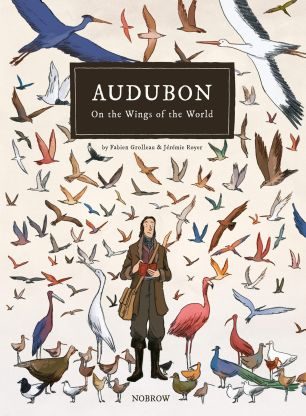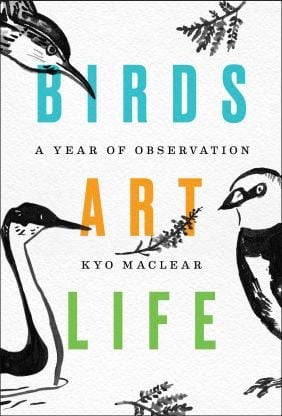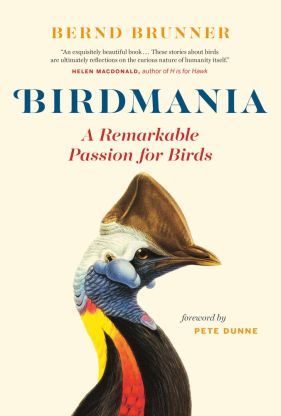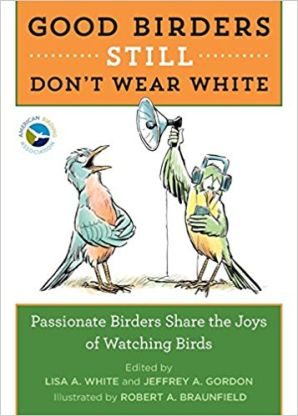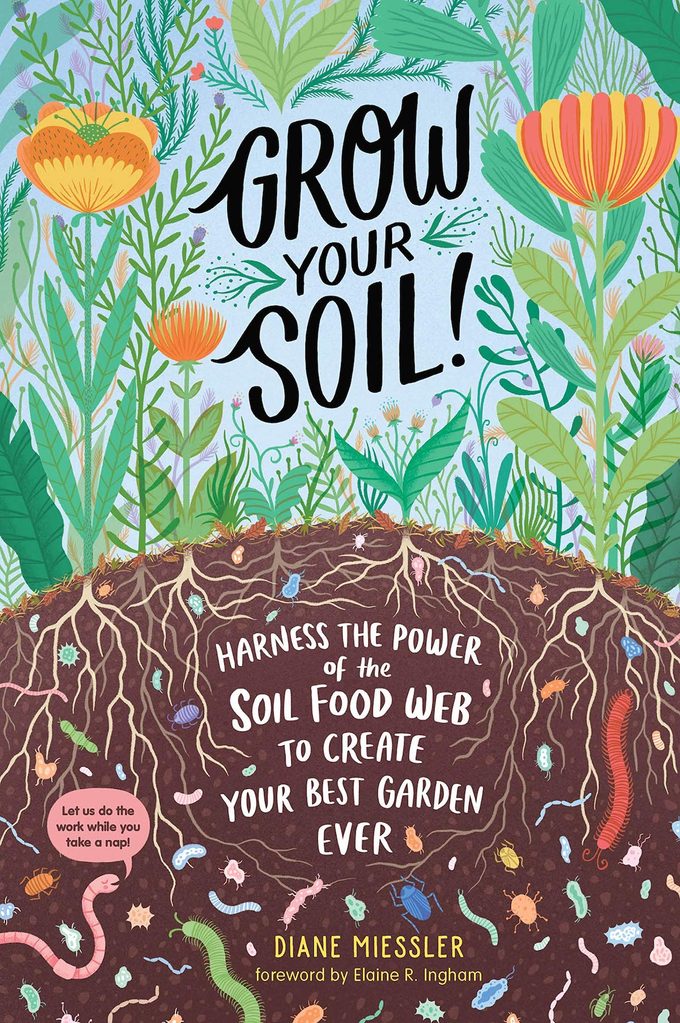On This Page
Birds That Eat Oranges
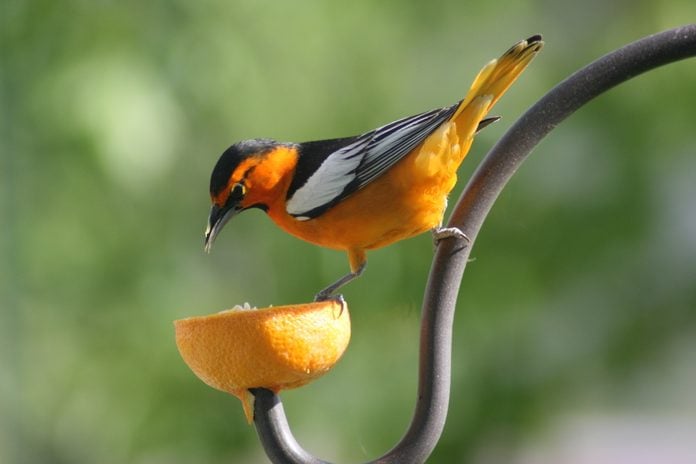
Orioles tend to steal the show in the backyard at fruit bird feeders because of their bright colors, but other fruit eating birds like oranges, too. Look for these other types of birds that might stop by to eat oranges.
- Gray catbirds
- Northern mockingbirds
- Red-bellied woodpeckers
- Western tanagers
- Brown thrashers
- Scarlet tanagers
- Rose-breasted grosbeaks
Discover 10 birds that look like orioles.
When to Put Out Oranges for Birds

You’ll have the best chance of success if you put oranges and fruit bird feeders out in spring. Try to anticipate when orioles will arrive in your backyard. If orioles heading north find a good feeding spot, they may just stick around for nesting season and beyond, which means you can see baby orioles for the entire summer.
How to Choose Fruit Bird Feeders
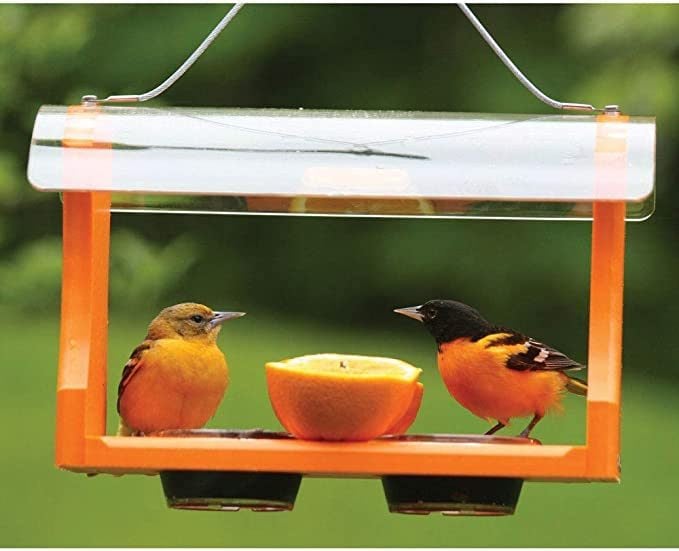
Perhaps one of the best things about feeding birds oranges is the low maintenance. You don’t need a snazzy feeder. Simply hammer a nail to a deck railing or fencepost and stick an orange half to the nail. Or set a couple of orange halves right in your platform feeder. Easy peasy! Here’s more ideas for DIY oriole feeders.
If you are interested buying in a special feeder for orioles, choose one that is orange colored to catch their eye as they’re flying over your yard. Some oriole feeders also offer sugar water and grape jelly.
Learn more about how to feed orioles.
More Fruits to Feed Birds

Don’t stop at oranges. Birds who enjoy a sweet orange treat will often eat other ripe fruit, too. Put out apple halves the same way as oranges. Set an overripe banana, a couple of handfuls of grapes or even chunks of melons on a platform feeder and have fun watching which birds fill up on fruit. Find out what birds can eat from the kitchen.
If you’re offering fruit for birds, you might just attract bonus winged visitors. Some butterflies and moths are attracted to fruit, too! Here’s how to make a DIY fruit feeder for butterflies.
Also plant berry bushes and fruit-bearing trees to make your backyard more attractive to orioles and other fruit eating birds. Try crabapple and raspberries.
Psst—orioles can’t resist this oriole nectar recipe.
Keep Fruit Bird Feeders Clean

As you can imagine, fresh fruit spoils quickly, especially in the spring and summer sunshine. Make sure to clean your feeders every few days, remove moldy remains and replace with a fresh batch of fruit.
Next, learn how to identify Baltimore oriole birds.
What Does a Bewick’s Wren Look Like?
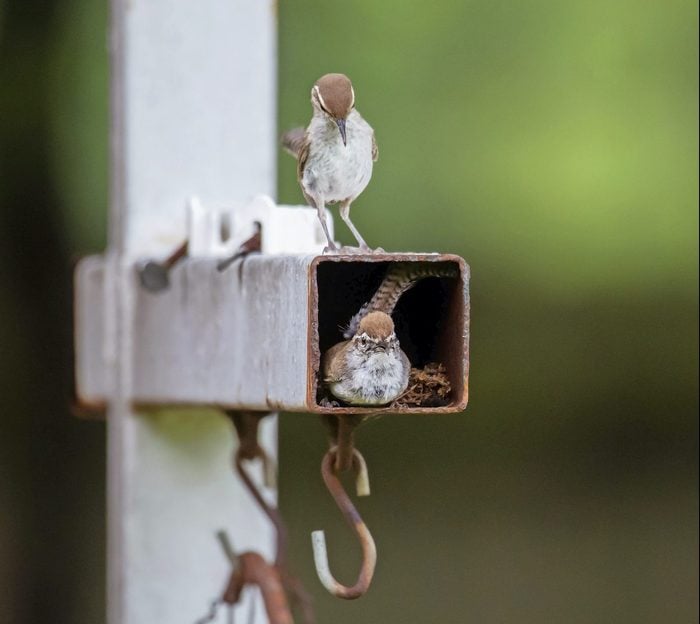
Bewick’s wrens are perky brown colored birds with bold, white eye stripes, similar to the Carolina wrens that are commonly seen in the East.
“This is a pair of Bewick’s wrens (above) who used the open end of this post for their nest one year,” says Birds & Blooms reader Michelle Summers. “The previous year, Carolina chickadees used this spot. I love the birds and put a good deal of effort into providing water, food and nesting facilities for them. Sometimes they choose things like a post in just the right spot over a cute little wren bird house, but that’s OK with me. It is always special to me to witness these tiny little families grow!”
Learn how to attract and identify a house wren.
Range
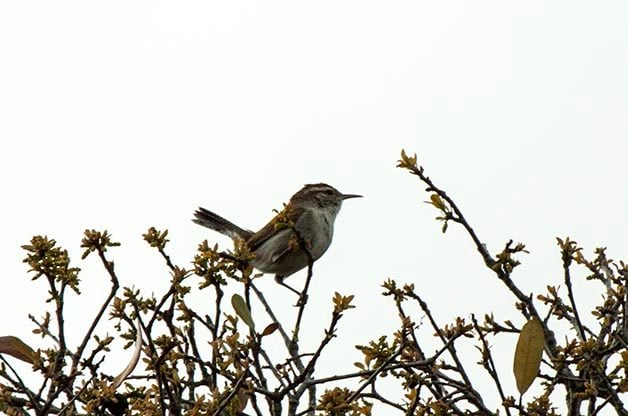
Look for Bewick’s wrens across most of the western United States. Though common across their range, these songbirds are rarely spotted east of the Mississippi River.
Head southwest to see a cactus wren.
How to Attract Bewick’s Wrens

In the west, some wrens, including Bewick’s, can be lured to backyards with native shrubs and brush piles. Look for them hopping and crawling down low as they forage for insects. You may also attract them to visit a bird bath, especially if it has a small fountain or dripper.
Like other wrens, these birds frequently nest in cavities such as old woodpecker holes and manmade nest boxes.
Next, enjoy delightful pictures of wren birds.
Books About Birding

The Backyard Bird Sanctuary
If you’re just starting out learning about common birds and want to design an ideal wildlife habitat in your yard, The Backyard Bird Sanctuary is a useful book about birding to get started. Pair it with the companion Backyard Bird Journal so you can record your sightings.
Florida Scrub-Jay
This award-winning birding book calls attention to a the threatened Florida-scrub jay, a striking member of the corvid family of birds that is at risk due to vanishing habitat. Learn about conservation efforts that are taking place to protect this beautiful bird from extinction.
Birding Without Borders
In Birding Without Borders, read how one birder set out to see half of the world’s bird population within the span of a year. His journey takes him to 41 countries and all seven continents, and he shares all the ups and downs of his Big Year. Check out bird and nature books for kids that make perfect gifts.

Birds of North America
Page through this gorgeous birding book, offering detailed photos of more than 550 birds. Many of the species featured in Birds of North America are shown in various plumage stages, helping readers better identify birds in different life stages. Check out our favorite hummingbird books.
The Bird Way
Birding enthusiasts and casual observers alike will be enthralled by The Bird Way. Take a deep dive into the world of birds and what we know about their behaviors. Learn more about famous birds in literature.
How to Know the Birds
Beginner birders get a fun introduction to 200 species in How to Know the Birds, a collection of essays and sketches. Psst—we found the perfect books to keep gardeners busy in winter.
The Sibley Guide to Birds
Every birder needs a solid field guide to take on their adventures. The Sibley Guide to Birds is full of hundreds colorful images and detailed descriptions to help you identify more species.
Everyday Birdwatching Stories Book
If you enjoy looking for birds in the backyard and beyond, you’ll love the Everyday Birdwatching Stories book. It is filled with spectacular pictures and heartwarming personal stories about special bird sightings, from orioles to owls. Plus, each chapter features expert advice to help you attract more birds in every season.
Audubon, On the Wings of the World
Perhaps the most unique book about birds, this is John James Audubon as you’ve never seen him before. If you’re new to the idea of graphic novels, you might flip open this tome and think, “A comic book about Audubon?” Dig deeper and you’ll find a beautifully-illustrated story about the famous ornithologist and his life and travels, including controversial topics like the number of birds he killed as he explored. This is no children’s picture book, but instead an immersive experience where the artwork helps you understand more about the story as it unfolds.
Birds Art Life
During difficult times, many people turn to the solace of nature. So it was for author Kyo Maclear, who found the joys of urban birding to be a balm during a challenging year of her life. In this intimate book, she tells the story of her year exploring birding in depth for the first time, and reflects on the life lessons found therein.
Birdmania
Quick – aside from Audubon, how many other well-known ornithologists can you name? Drawing a blank? That’s OK, because Bernd Brunner’s book, Birdmania, will quickly fill in the gaps for you. Brunner relates the fascinating tales of birders throughout time; some have made important contributions to our scientific understanding of birds, others dedicated their lives to conservation, and a few simply became obsessed with the birds they loved. The book is beautifully decorated with paintings, illustrations, and other artwork to enhance the reader experience.
One More Warbler
Author Victor Emanuel is one of the country’s leading birders, and his birding tours attracted celebrities like Prince Philip and Laura Bush. In One More Warbler, Emanuel recounts his stories one bird at a time, starting with the male cardinal that first caught his eye when he was just a boy. He shares tales of his mentors and epic adventures of birding around the world, each vignette sparked by a bird that helped to shape his life. You may not be able to take a birding tour in person with this charismatic man, but his book will let you travel right along with him.
Good Birders Still Don’t Wear White
If you’ve ever enjoyed a chat with other folks who love birds, this humorous book is for you. Dozens of avid birders share what makes birding special to them in this follow-up to the original Good Birders Don’t Wear White. Birding guides, bird photographers, museum curators, and many more relate their experiences with birds in short essays that will make you smile, laugh, and perhaps even cry a little. Illustrated with the charming line drawings of Robert A. Braunfield, this is one of those books about birds that has a little something in it for everyone.
Gardening Books
Vegetable Gardening for Beginners
Use helpful vegetable gardening book to plan out your garden, from how to pick the best spot for a garden bed to pairing up the best vegetables to grow together. Check out harvest-themed gifts for vegetable gardeners.
Up in the Garden and Down in the Dirt
This delightful children’s picture gardening book introduces young ones to all the creatures who live just below a garden’s surface. Check out gift ideas for kids who love birds and nature.
Grow Your Soil!
This gardening book looks below the surface. In Grow Your Soil, learn why the soil you start with is so important to the health of your garden—and how to improve your soil in unique ways. Here’s the best potting soil for every type of plant.
Raised Bed Gardening for Beginners
While you’re a beginner or experienced gardener, turn to this helpful gardening book for everything regarding creating raised beds. In addition, discover which plants are the best partners in a raised garden bed.
Floret Farm’s Cut Flower Garden
If you’re a fan of cutting gardens and arranging your own flowers, this book offers instructions for how to create your ideal garden. Cut Flower Garden also features step-by-step instructions for how to create a variety of arrangements and garlands.
Males and females of many bird species display different traits and behaviors, and this is especially true for hummingbirds. Next time you’re sitting by a backyard sugar-water feeder, use these clues to identify hummingbird male vs female flyers.
Learn how to attract hummingbirds with 10 expert tips.
Male vs Female Hummingbirds

According to Peter Pyle, staff biologist at The Institute for Bird Populations, the real difference between an adult male vs female hummingbird is in the head and neck feathers.
“The adult males are all pretty straight forward to identify just based on the coloration of what we call the gorget, which is the throat feathers, and the crown feathers, which are the glittering ones on the head that really flash when they hit the light correctly,” says Peter.
What makes hummingbird feathers so shimmery? Can hummingbirds walk?
Females do not have full bright gorgets like the males. Instead, they sport white throats that are sometimes spotted with dull gray-brown dots, and perhaps a small patch of iridescent feathers, depending on the species. They also tend to have slightly less vibrant back and wing feathers.
Discover 22 jaw-dropping hummingbird facts.
Why Male Hummingbirds Have Flashier Feathers

Male hummingbirds have showier feathers for one reason: to attract potential mates.
Peter says, “it’s all for display purposes.” He notes that they have an impressive trick to get the females’ attention.
“The males can flip their gorget feathers in the sun,” explains Peter. “So when a female lands near a male at his courting post, he knows how to flip his throat so it can look like a strobe light that flashes on and off.”
If you see a male and female hummingbird together in the breeding season, try to stand behind the female without disturbing them. You may be able to catch the flashes of his glittery throat in a courtship display.
Peter says that some males are better at this trick than others. That could be because they are more experienced or have fuller gorget feathers. “And that means that they are better conditioned birds,” he adds. “It helps a female choose a male who is better or higher quality, and her offspring will be more likely to survive.”
How fast do hummingbirds fly and flap their wings?
Young Hummingbirds vs Female Hummingbirds

In summer and fall, birders have a new challenge when young birds become more active and leave the nest and migrate south.
It’s relatively easy to tell an adult female and male hummingbird apart, but adult females and immature males are much easier to misidentify.
“You have to look at the details on the throat to tell a young male from a female—and in some species you really can’t,” says Peter. That’s because young male hummingbirds don’t hatch with bright neck feathers like the adult males have.
Peter explains that male hummingbirds start to get hints of their adult gorgets about a month after leaving the nest, which is around August or September in many areas. But it can happen even earlier in some species of hummingbirds, like the rufous hummingbird.
In late summer, you can rely on clues from the throat again. Young male hummingbirds may have scattered iridescent feathers or heavier dusky spotting on their throats.
The males grow up fast. After arriving at their wintering grounds, Peter says that they go through the complete process of molting and look just like the older males afterwards.
Juvenile females are far less confusing—they look basically the same as the adult female hummingbirds by the time that they leave the nest.
Size of Male and Female Hummingbirds
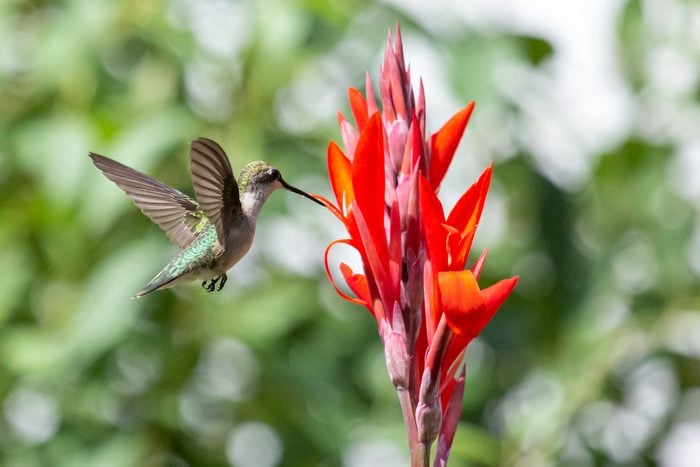
You may not believe it, but hummingbirds share something with birds from the raptor family. In general, females from both groups tend to be slightly larger than males. Meet the world’s largest and smallest hummingbirds.
“With raptors like owls and hawks, the females are bigger and there’s a really elegant theory behind that, involving prey size brought in to feed chicks,” Peter says. But he notes that it is unclear to researchers why female hummingbirds are larger than the males.
Along with their heftier build, female hummingbirds also have a longer bill. Learn how hummingbirds use their tongues and bills.
Do Males and Female Hummingbirds Behave Differently?

You may also be able to identify a male vs female hummingbird depending on what it is doing. During the breeding season, these birds take on dramatically different day-to-day tasks.
The males spend their time perched on top of trees and shrubs when they aren’t looking for food. They use these lookouts to defend their territory and feeders from rival males and to keep an eye out for females to mate with.
“It’s typical with all birds that bigger, stronger males may dominate a little bit more and be aggressive—especially towards other males,” says Peter.
He says Anna’s hummingbirds are the most common hummingbird species at his home in California. If you set a feeder up behind a house he adds, “an adult Anna’s will typically take over and case any other hummingbirds away from it, including females and young birds.”
Male hummingbirds are fiercely territorial, but that doesn’t make them good fathers. In fact, female hummingbirds do all of the work raising young. So if you see an adult bird in a hummingbird nest or tending to nestlings, you can be sure that it is a female.
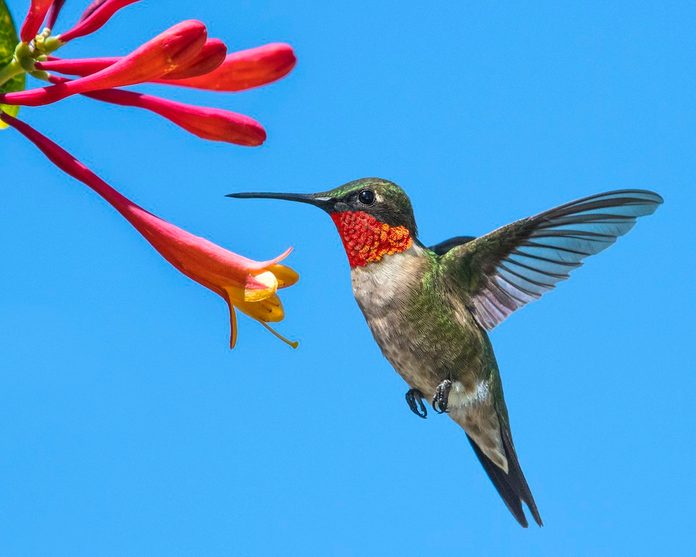
When you think about hummingbirds, you probably think about flying. That’s understandable — the buzzy little birds are known for their fast-flapping wings and unusual style of movement. But what about hummingbird feet? How do hummingbirds use their feet, and can they walk? John Shewey, author of The Hummingbird Handbook, helps us break down the mysteries behind hummingbird feet.
Can Hummingbirds Walk?
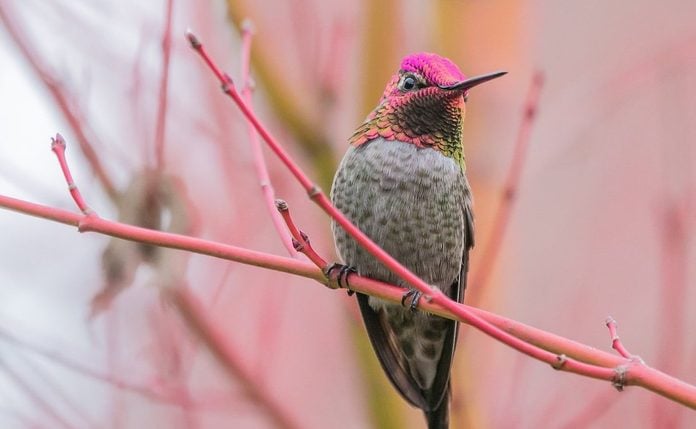
Surprisingly, the answer is “no.” Hummingbirds don’t have the ability to walk like other birds do. Why is that? John explains: “Hummingbird legs and feet are structurally similar to other songbirds but comparatively reduced in size,” he says. He explains that a hummingbird’s incredible flight skills enable it keep pace with a flower blowing in the wind — but from an evolutionary standpoint, that amazing ability came at a cost.
“Weight is the enemy of flight, so hummingbirds evolved relatively small legs and feet to save on weight,” John says. He says the birds’ bodies are put together in a way that “emphasizes extreme flight dynamics that do not require highly developed ‘foot capabilities,’ like those seen in birds that rely on walking or specialized perching. Like woodpeckers, for example.”
Hoping to attract more hummingbirds to your yard? Check out our answers to frequently-asked hummingbird feeding questions.
How Do Hummingbirds Use Their Feet?

With that said, just because hummingbirds don’t walk or hop like other birds doesn’t mean hummingbird feet are useless. John notes that hummingbirds do have some mobility with their feet, and they are adept at “scooching” sideways.
Psst—hummingbirds are all about speed — you’ll be amazed by how rapidly their tiny hearts beat.
“They use their feet to grip tiny perches such as twigs, or even human objects like fence wires and tomato cages,” he says. “The feet also serve the critical purpose of helping the birds preen and clean their feathers. Clean, well-groomed feathers are important for flight as well as insulation and temperature regulation.”
Discover even more jaw-dropping hummingbird facts.
Ask the Experts

“My husband and I saw a hummingbird flying around with a cocoon on its foot. What’s going on? asks Laurie Stuchlik of Milton, Delaware. Birding experts Kenn and Kimberly Kaufman say, “Hummingbirds have relatively small, weak feet, and they don’t intentionally use them to carry anything. But sometimes they get one foot tangled in something, and if it isn’t too heavy, they may fly around that way. The females use their bills to gather pieces of spider web and other soft materials to use in their nests, and they may pull off silky strands from moth cocoons. The bird that you saw might have been doing that when it got one foot tangled in the loose outer covering of the cocoon. Usually such an impediment will fall off before too long.”
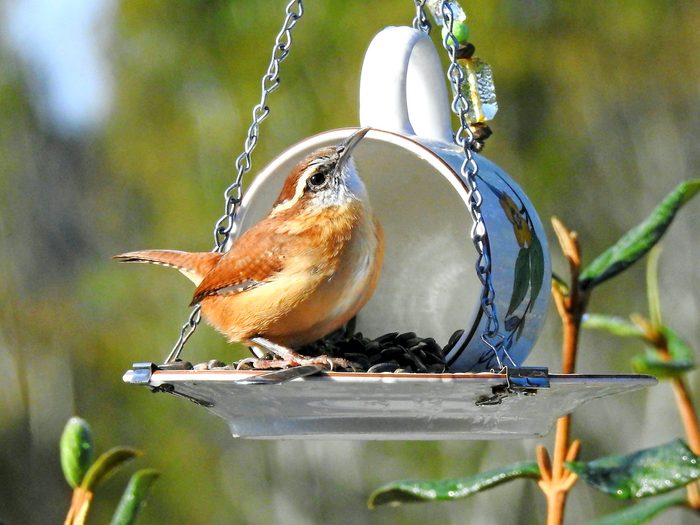
A wren’s cheery chirping is a delightful summer sound. If you’re longing to hear a wren in your backyard, you might wonder: what do wrens eat? Turns out, there are a variety of things you can add to the menu for these adorable little birds.
What Do Wrens Eat in Summer?
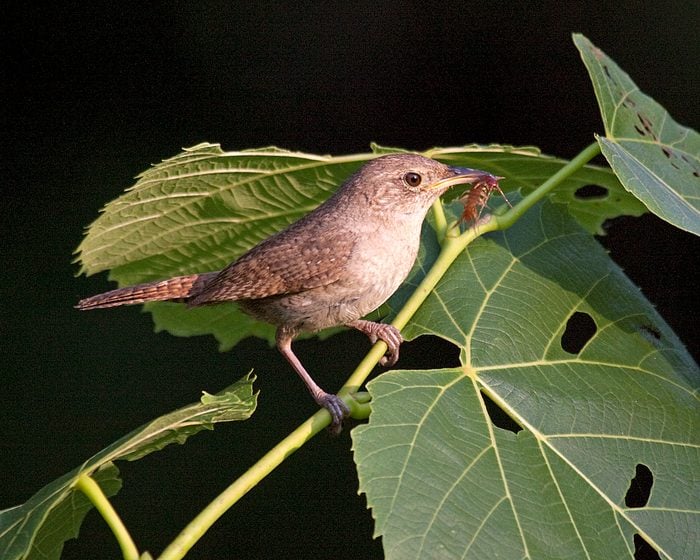
In summer, your best bet to attract a wren (besides putting out a wren house) would be to have a backyard full of insects. Wrens don’t typically visit feeders, instead preferring to snack on bugs. So your best bet is to grow a variety of native plants and flowering shrubs that attract beneficial bugs.
What’s the difference between a Carolina wren and a house wren?

And if you thought mealworms were just for the bluebirds, you thought wrong. Wrens eat them, too. That might come as a surprise, but it’s true — mealworms are another wren favorite food. Offer them in a mealworm feeder to draw a crowd of bug-loving birds (wrens included).
Like other birds that don’t come to feeders, wrens are attracted to moving water. Birding experts Kenn and Kimberly Kaufman say having a bird bath — especially one with a a waterfall or small dripper — might bring the wrens in for a drink. Cactus wrens, which live in the desert, can go long stretches without water, as they get what they need from eating bugs and fruit.
Wren vs sparrow: What bird are you seeing?
What Do Wrens Eat in Winter?

In winter when insects are less readily found, wrens’ diet preferences change. Cooler temperatures mean they’re more likely to stop by feeders. Carolina wrens will sometimes eat suet. They are more likely to visit feeders in winter than house wrens, which migrate south to warmer climates.
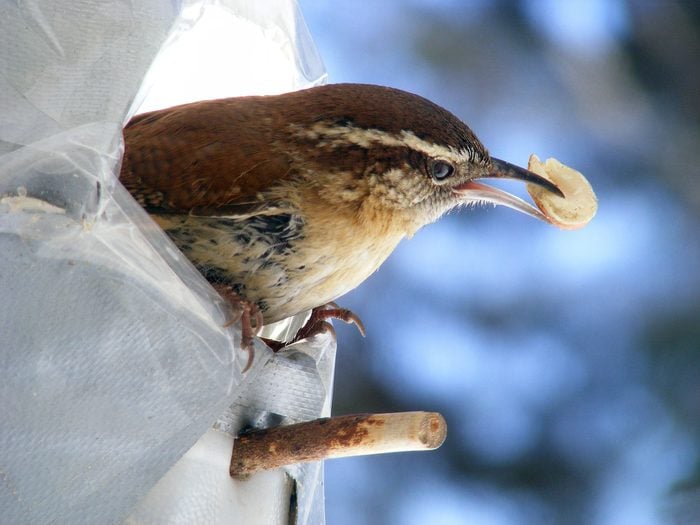
Like blue jays, nuthatches, woodpeckers and many other birds, wrens also eat peanuts. They prefer chopped peanuts, rather than whole. Because of their beak size, they could have a hard time with a shell. All types of wrens enjoy peanuts, so putting out a peanut feeder is a great way to draw your local wrens to your yard. Always remember to offer only plain unsalted, unseasoned nuts for your backyard friends.
As far as basic birdseed, wrens, like cardinals, grosbeaks and finches, may enjoy snacking on sunflower seed.
Next, enjoy delightful pictures of wrens.
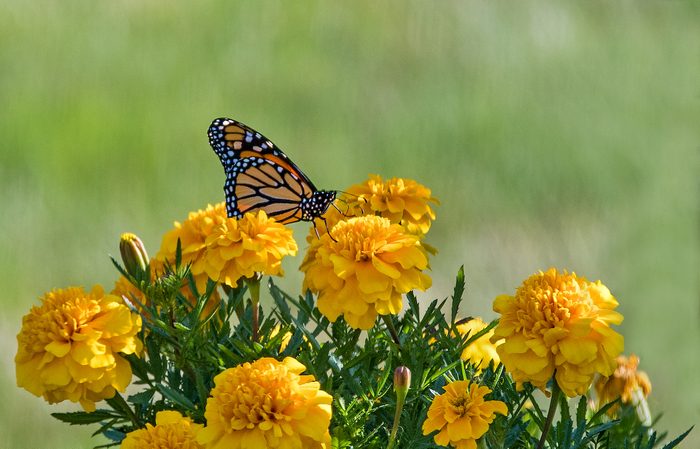
There are two vibrant October birth flowers: marigold and cosmos. Both flowers are quick and easy to grow. In addition to adding eye-catching pops of color to any garden, marigold and cosmos attract summer pollinators, like hummingbirds, bees and butterflies.
We can’t get enough marigolds and cosmos, and noticed they make a perfect theme for October birthday gifts. Who doesn’t love a personalized gift inspired by flowers?
If you’re not celebrating any October birthdays, don’t worry. We’ve got you covered with birth flower gift guides for January, February, March, April, May, June, July, August, September, November and December too.
What Are October’s Birth Flowers?

October has not one, but two birth flowers: marigold and cosmos. Both of the October birth flowers are vibrant, colorful annuals that bloom from summer to fall.
Marigolds are colorful flowers that come in the radiant shades of sunshine: yellow and orange. They’re wonderful at attracting butterflies, hummingbirds and other pollinators—plus, they’re deer-resistant. Their strong scent is a turnoff for most deer, although they still snack on them from time-to-time. Marigolds and cosmos are also miracle workers at attracting birds. If you have marigolds in your garden, don’t forget to deadhead flowers to keep your garden blooming.
Cosmos are beautiful, easy to grow annuals. These traditional cottage garden plants grow fast and tall. In fact, some can grow up to six-feet tall, making cosmos an excellent choice for garden borders. Their daisy-like flowers are known for their symmetrical, orderly blooms. Cosmos come in a range of colors, and there’s even one known as the chocolate cosmos. It’s as delicious-looking (and smelling!) as it sounds. Here’s why cosmos flowers are beloved by bees and butterflies.
What Are the Meanings of October’s Birth Flowers?

Bright orange and yellow marigolds represent optimism and prosperity. In addition to being associated with October birthdays, they’re also linked with the end of life and afterlife. Marigolds are commonly used during Dia de los Muertos, which is a celebration of life and a way to honor those who have passed away. It’s believed that the bright colors and strong scent of the marigolds will guide the souls of loved ones to their families during the celebration.
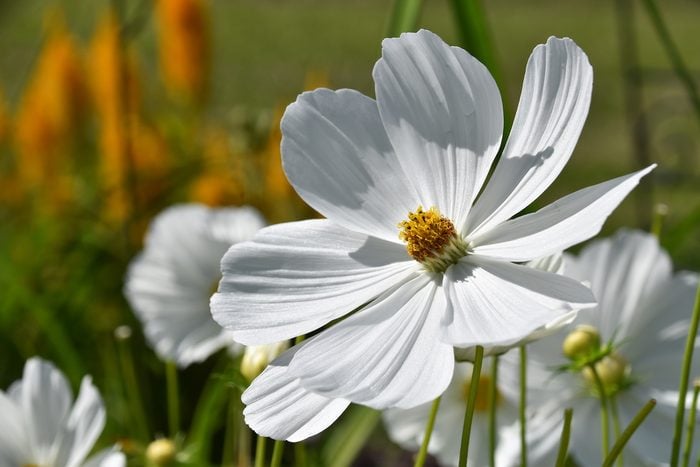
Cosmos symbolize order, peace and harmony. The meaning is derived from the origin of its Greek name, “kosmos,” which means order and harmony of the world. With that, the flower’s evenly placed petals inspired the name, cosmos.
Now that you know more about October’s birth flowers, we’ve got the perfect gifts for everyone on your October birthday list—from elegant letterpress stationery and flower seeds to relaxing shower steamers and everything in between.
Do monarch butterfly sightings have meaning?
October Birth Flower Gift Guide
Marigold Flower Grow Kit

Give the gift of an all-in-one marigold grow kit to someone celebrating an October birthday. This kit includes everything needed to grow colorful blooms: marigold seeds, a glass bottle, soil-less growing medium, instructions, and information about what marigolds symbolize.
Cosmos Shower Steamers

This charming box of aromatherapy shower steamers is a thoughtful way to gift a little relaxation to anyone on your October birthday list. The fizzy cubes are packed with essential oils inspired by cosmos and dissolve in the shower. Who needs a bathtub?
Cosmos Tote Bag

Show your love for the environment with this sustainable canvas tote bag featuring an illustration of cosmos on the front. Ideal for running errands or going to the grocery store, this tote will come in handy at all times.
Marigold Seed Mix

Add a pop of color to your loved one’s garden with this marigold seed mix. This pack includes 1,000 heirloom, non-GMO seeds. They’ll be enjoying gorgeous, sunset-toned marigolds in no time.
Marigold Earrings

These homemade birth flower earrings are a beautiful way to enjoy marigolds all year long. The resin pendants include a real marigold petal, stem and leaf, and hang from a sterling silver earring wire.
Marigold Letterpress Stationary

This elegant letterpress stationary set is sure to leave a lasting impression on any gift recipient. Each card features three marigold blooms pressed in the ink color of your choice: honey gold or tangerine orange. For a personalized touch, customize the notecards with your loved one’s name. Stunning!
Cosmos Cupcakes Blush Seed Mix

These blush cosmos seeds add unique blooms to any garden. Their unique zig zag edges and tufted middles mimic paper cupcake wrappers, hence their delicious name. Grow them in the garden, then cut to enjoy in bouquets.
Marigold Enamel Pin Set

Show your loved one you care with this marigold enamel pin set. Each set includes four marigold pins; one in each color: yellow, red, pink and orange. These pins look lovely clustered together on a jacket or individually on a collar as a small accent piece.
Marigold Watercolor Art Print

This print of an original watercolor flower painting is a gift that will be admired for years to come. The reproduction of the original artwork includes a colorful bouquet of marigolds, along with the name of the month and flower. Note: a frame is not included.
Personalized Cosmos Mug

Celebrate October birthdays every morning and all year-long with this birth flower mug. Available in a variety of sizes (there’s even a to-go option), this mug displays a hand-drawn bouquet of cosmos, along with the name of the flower, birth month and their symbolism. Personalize this gift with the name of your choice. Too cute!
Next, check out more gifts for nature and outdoor lovers.

Watering Ferns
Whenever I use an egg, I drop the shell in a container of water with a lid on it and save it until it’s time to water my ferns. In less than a year, one fern outgrew its pot, then was planted in a larger pot. I had to transplant it again later! I thank my mother-in-law for sharing her eggshells garden tip with me, says Birds & Blooms reader Rhonda Zimmerman.
Discover 10 ways to use Epsom salt for your garden.
Eggshells in Potting Soil
I save eggshells all year then crush them in the spring and mix them into the soil around my tomatoes. Planting sweet basil with or near the plants also seems to improve the yield, says Julius Frank.
We found 6 genius garden hacks you’ll want to steal immediately.
Start Garden Seeds in Eggshells
Ordinary eggshells can give your plants a nice early start indoors. Break several eggs so the halves are intact. Place them in an empty egg carton, fill the shells with good soil and plant your seeds. When the weather’s warmed and the plants have grown enough to be transplanted, all you have to do is crack the shells around the roots and plant them—shell and all. The shells act as a slow-release natural fertilizer, says Glenna Roberts.
Discover 6 ways to use baking soda in the garden.
Add Eggshells in Garden Compost
In winter, we compost our biodegradable matter. Coffee grounds, egg shells, vegetables and fruit all contribute to the pile. We aerate it with a pitch fork, says Sue Steele.
Stop Slugs
Add an inch of coarse eggshells in a 3-inch-wide band around plants. In dry weather, slugs won’t cross over the sharp material to get to their buffet.
Check out 10 natural ways to eliminate garden insect pests.
Provide a Calcium Source for Nesting Birds
Some birds—particularly blue jays—seek out calcium as a needed supplement, especially during the breeding season. Try offering the birds some eggshells. Be sure to sterilize the eggshells first by either boiling them for five minutes, or heating them in the oven for 30 minutes at 250 degrees, say birding experts Kenn and Kimberly Kaufman.
What can birds eat from the kitchen?
DIY Fertilizer
I make my own fertilizer by boiling and baking old eggshells until dry. Then I grind them into a fine powder with my food processor, says Jennifer Broadstreet Hess.
Next, check out secret garden tips we learned from Grandma.
Which Yellow Tanager Are You Seeing?

Spotting a tanager is always a treat for birders. Male scarlet tanagers and summer tanagers are bright red birds, but you might not realize that the females of these species are actually yellow. The Western tanager is also a primarily yellow and black bird with red on its head. Learn how to tell which yellow tanager you are seeing in the backyard.
Discover 8 surprising facts about tanagers.
Female Summer Tanager

One of the easiest ways to determine which yellow tanager you are seeing is by looking at the bird’s range map. Summer tanagers are most commonly found in the southern states when the weather warms up. Also, pay attention to the lack of field marks. Female summer tanagers are a solid color yellow with no black or red markings on the wings, head or tail. Look for a large bill to distinguish it from other small yellow birds. You may be able to attract tanagers with the grape jelly you put out for orioles.
Yellow warbler vs goldfinch: Here’s how to tell the difference.
Female Scarlet Tanager

To identify a female scarlet tanager, look for a bird that looks just like its male counterpart, with black wings, but in a muted yellowish green color instead of red. Scarlet tanagers breed farther north than summer tanagers; look for them farther south during spring migration. Do scarlet tanagers eat oranges?
Western Tanager
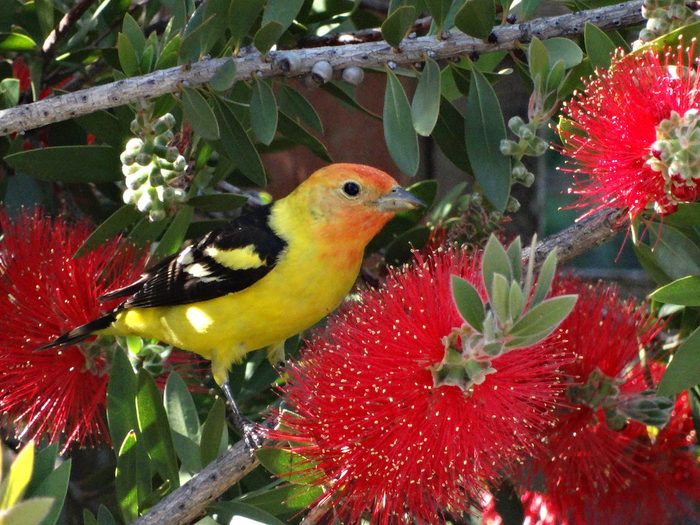
As their name indicates, colorful Western tanagers are typically only found in the western half of the United States during spring migration and summer. They have black wings and tails like scarlet tanagers, but with bright yellow bodies and red heads in the breeding season. Also look for a distinctive yellow shoulder patch and white wingbars.

Female western tanagers look more muted, pale yellow and gray, without the reddish head coloring. In the southwest, also look for yellow female flame-colored and hepatic tanagers.
